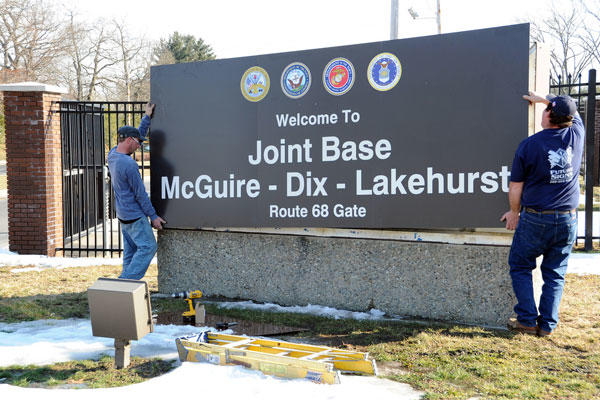The U.S. Army is considering whether to abandon a controversial program to consolidate military bases from across the services, its top officer said.
The Army has encountered some problems with the program, known in military parlance as joint basing, and plans to review the effort with the other services to determine whether it continues to make sense, said Army Chief of Staff Gen. Raymond Odierno.
"It's time for us to do an assessment," he said during a recent panel discussion.
"Some of us are saying: 'Are we getting benefits out of it? Is it working? Are we having problems?' Because in some places, we are having problems with joint basing," Odierno said. "So we're taking a hard look at this ... then we'll move forward on what we think the way ahead is."
Lt. Gen. Bill Grisoli, director of the Army staff, has formed a group with his counterparts from the other services to review the issue, Odierno said.
In response to a recommendation from the 2005 Base Closure and Realignment Commission, known as BRAC, the Defense Department created a dozen joint bases around the country by consolidating 26 installations that either shared a boundary, or were located close to each other. For example, the Army's Fort Lewis near Tacoma, Wash., and the Air Force's McChord Air Force Base became Joint Base Lewis-McChord.
The consolidation of infrastructure was supposed to save money in part by eliminating redundant services to train and equip forces. However, government auditors now say the savings may be minimal because the installations adopted costly new standards for everything from airfield operations to ground maintenance.
As a result, the Pentagon's estimated savings from the program over two decades has declined almost 90 percent to about $250 million from $2.3 billion, according to an April report from the Government Accountability Office, the investigative arm of Congress.
The Pentagon's office of the deputy undersecretary of defense for installations and environment, now headed by John Conger on an acting basis, didn't have a plan in place to guide the cost-saving efforts "because joint basing is a relatively new initiative and they are still resolving implementation issues and working to achieve cultural change," the report states.
Speaking during a family forum at last week's Association of the United States Army conference, Odierno also cited cultural differences between the services as one of the challenges of joint basing.
"I don't have to tell you … there is a differing culture between the services," he said. "There's a difference in what we think we should have and there's a difference in what they think we should have and there's a difference in what they think they should and have and what we think they should have."
He added: "So we have to sit down and take a look at it, and are we truly reaping the benefits that we thought we would and what is the cost to our families and to our other programs that we have on the installations. So that's what we've asked them to take a look at."
George Wright, a spokesman for the Army at the Pentagon, said only a couple of years have passed since the commission's September 2011 deadline to start implementing joint basing. The services are still learning how to operate under the policy guidance and getting used to each other's business processes, he said.
For example, some family programs within the Air Force are managed by medical organizations whereas the same initiatives in the Army are overseen by non-medical personnel under the Garrison's Army Community Services offices, Wright said. Similarly, both the Army and the Air Force have different models for distributing funds for the Army & Air Force Exchange Service, he said.
"Each service has its own ideas of how to be more effective in delivering installation services and support," Wright said in an e-mail.
The GAO recommended the Pentagon help the joint bases identify potential areas for savings, such as paring unnecessary management personnel, consolidating and optimizing contract requirements, establishing a single authority to better utilize facilities, and reducing the number of base vehicles and equipment.
The office also recommended for the Pentagon to improve the reliability of cost and performance data from the installations, as well as communication between bases to resolve common challenges and share lessons learned.
Military.com Associate News Editor Amy Bushatz contributed to this report.


























